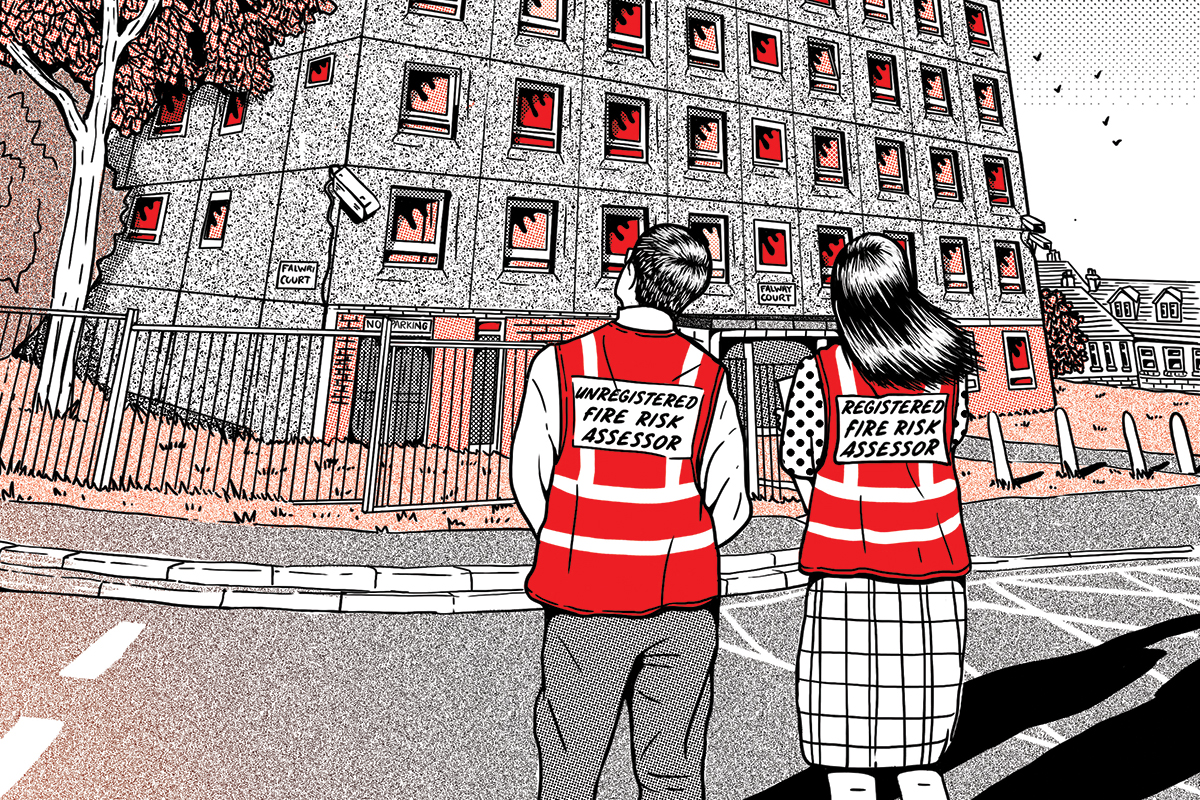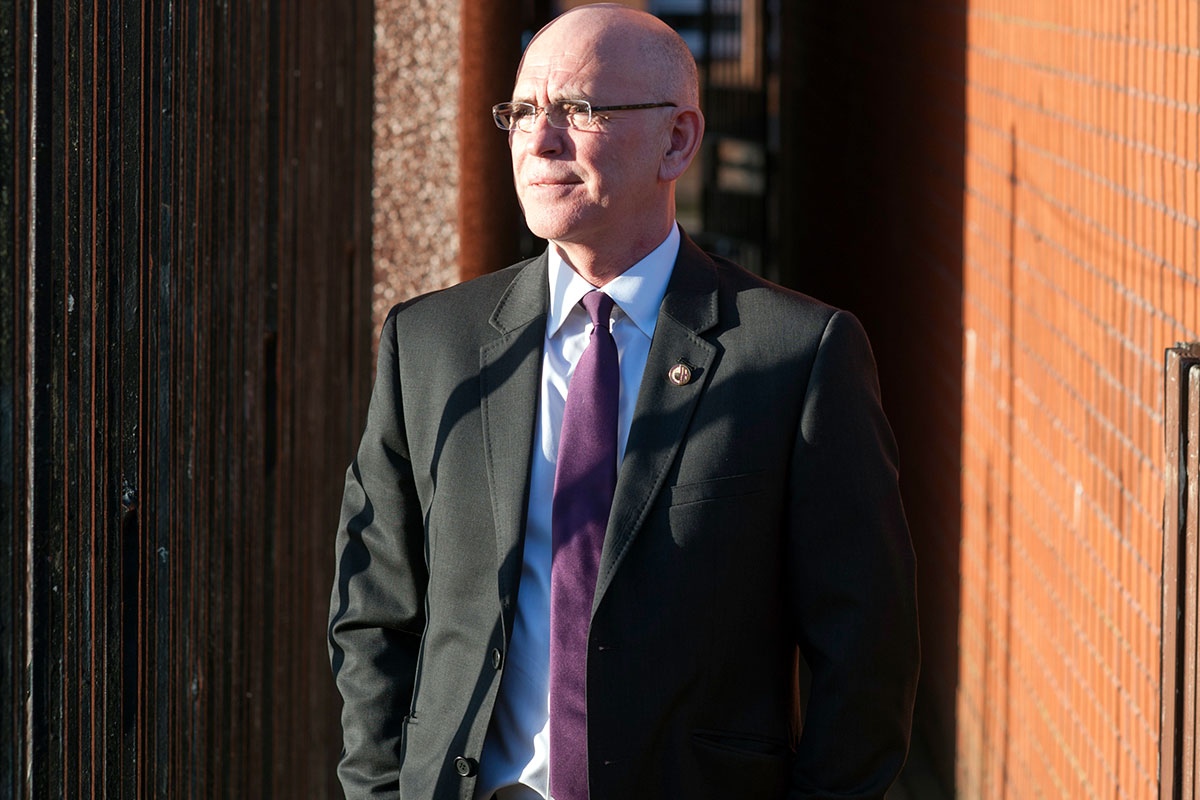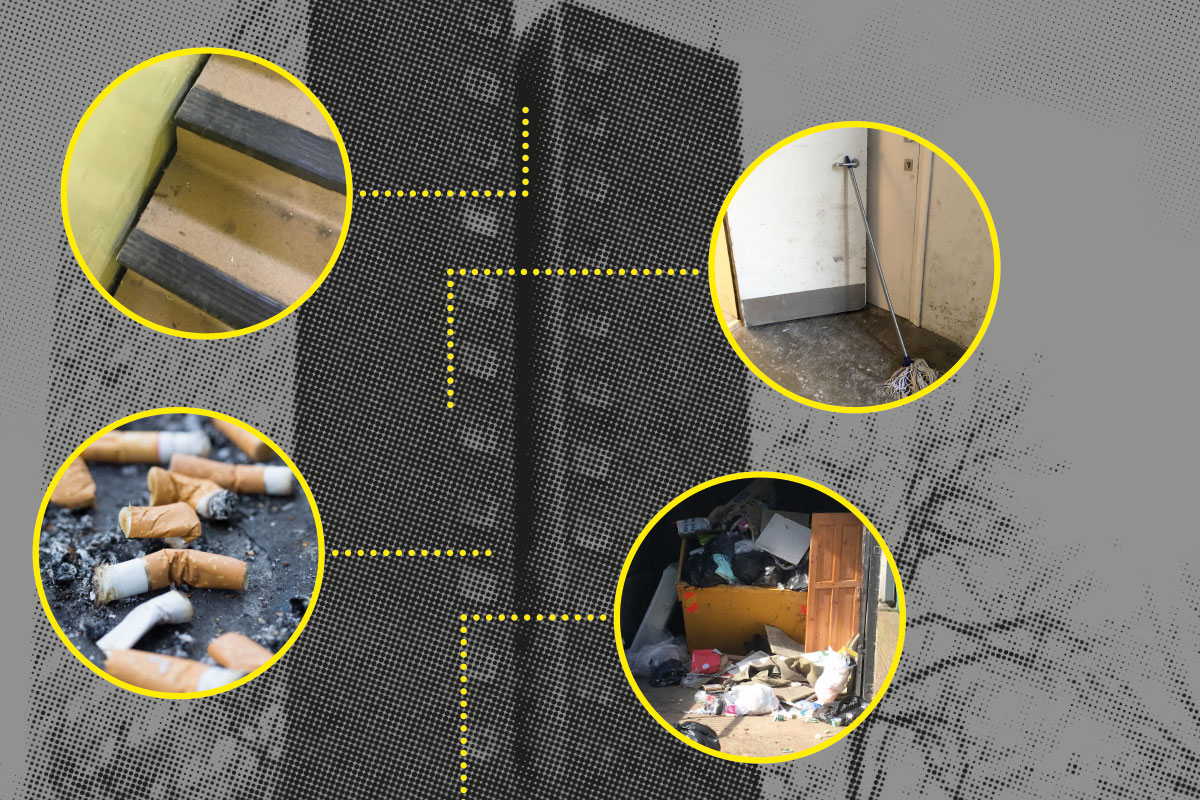You are viewing 1 of your 1 free articles
Who watches the watchers?: councils’ use of unregistered fire risk assessors revealed
Worrying new research by Luke Barratt reveals that many councils are using unregistered fire risk assessors to decide if their buildings are safe. Illustration by Cat Sims
Inside Housing Spotlight is a series of pieces showcasing the best of our investigative and data journalism.
Ask a social landlord for assurances about fire safety and it’s a safe bet that one of the first things they will tell you is that their tower blocks have undergone a fire risk assessment.
Regular risk assessment is a big part of most fire safety strategies – but how useful is it for keeping people safe? Grenfell Tower, after all, was risk assessed and it passed.
The truth is that the actual requirements for risk assessments would shock many.
Inside Housing has previously written about the prevalence of Type 1 assessments – which mean the assessment considers only the communal areas, and not the walls, windows or the inside of flats where many dangers can lie undetected.
But there are also questions over who actually carries them out.
"There is no competency requirement of any kind in the law"
In 2005, responsibility for risk-assessing moved away from the fire brigade and was passed to building owners.
On the matter of who should actually do a fire risk assessment, however, the guidance remains silent. There is no competency requirement of any kind in the law.
Seeking to avoid creating a “consultants’ charter”, the government of the day took the decision to leave it entirely up to the building owner to decide who was qualified to assess their blocks.
This means that should the reader of this article decide to offer their services as a risk assessor today, there would be no legally required training or registration before they were let loose on tower blocks with clipboard in hand.
It is not that there are no registers available for fire risk assessors – there are a total of eight lists of competent assessors, five of which have backing from UKAS, the UK’s national accreditation service. It’s just that the law does not require assessors to have their name on any of these lists.
This has been a source of concern for many years. In 2013, Peter Gannaway, chair of the National Social Housing Fire Strategy Group, warned that freedom for anyone to call themselves a fire risk assessor “posed a significant risk to public safety”.
“We need competent fire risk assessors and they need to be accredited,” said Ronnie King, chair of the All-Party Parliamentary Fire and Rescue Group, after the Grenfell Tower fire.
New research by Inside Housing sheds worrying light on the extent of this issue for the first time. We have obtained data from 128 local authorities about whether they have been using registered risk assessors.
Only 26 said all their assessors were registered, 23 used a mix of registered and unregistered assessors and 23 used exclusively unregistered consultants to assess the safety of their tower blocks.
Perhaps just as worryingly, the remaining 56 did not even know whether the professionals they had used were registered.
While there is no guarantee that an unregistered assessor will be worse, registration offers a third-party seal of approval that the qualifications possessed are relevant, appropriate and up to date.
While using unregistered risk assessors is legal, it goes against guidance.
In 2014, many major fire safety organisations came together to form the Fire Risk Assessment Competency Council (FRACC) and issued guidance on how to choose a competent assessor, identifying registers and recommending that building owners make use of them.
"While using unregistered risk assessors is legal, it goes against guidance"
Dennis Davis, chair of the competency workstream at the Fire Sector Federation (FSF) and author of that guidance, tells Inside Housing: “We [were] suggesting that was a useful, practical way of approaching fire risk assessments: to ensure at least that you were finding someone who was competent at doing that task.”
Despite this, it has been known for some time that not everyone was doing this. In February last year, Howard Passey, principal consultant at the Fire Protection Association (FPA), warned a seminar that there were hundreds of unregistered fire risk assessors operating around the UK.
The fire risk assessor for Grenfell Tower, Carl Stokes, has come under immense scrutiny since Inside Housing revealed his name in June 2017. He has been called to the Grenfell Inquiry as a core participant. As is common for Type 1 assessments, his work did not look at the cladding that has been widely blamed for helping the fire to spread up the building.
It is unknown if he was on any of the eight registers recommended by FRACC at the time.
Jonathan O’Neill, managing director of the FPA, which itself carries out fire risk assessments, explains why third-party accreditation is important. He tells Inside Housing: “Without any third-party assessment, virtually anyone can set themselves up and call themselves a fire risk
assessor. There is no real requirement to have any insurance, to have anyone give you accreditation whatsoever.
“It’s quite a complicated business, particularly the high-risk stuff. Even people who have been in our organisation some time, if they’re going into fire risk assessment, it’s probably two years since the start of training before we’ll let them out on their own.
“If you get it wrong, it’s people’s lives you’re playing with.”
"Without any third-party assessment, virtually anyone can set themselves up and call themselves a fire risk assessor" Jonathan O’Neill, FPA
There are some councils that agree with this. One of the 26 to have used only registered assessors, Brent Council, stated in its response: “The specification for the contract [for fire risk assessment] includes the requirement that all assessors are third-party accredited under a recognised scheme. The register used is FRACS (the Fire Risk Assessors Certification Scheme).”
Mr Davis said the FSF’s position is “that it should be a statutory requirement that you have someone who’s shown to be competent and that means, really, a demonstration of competence”. He added: “In our view, it would be someone who has third-party accreditation.”
Among the 23 councils that have used a mix of registered and unregistered assessors, one argument may be that the unregistered assessors are used on lower-risk homes. One of these – Reading Borough Council – said in a statement: “The [FRACC] guidance makes clear that there is no requirement to use registered fire risk assessment companies for simple and low-risk properties. Reading Borough Council, with guidance from Royal Berkshire Fire and Rescue Service, have deemed its flats to be in this ‘low-risk’ category.”
Local authorities and ALMOs using no registered fire risk assessors since 2010
The councils and ALMOs listed below told us that none of the fire risk assessors they’ve used since 2010 were registered with a third-party accreditation body:
- Barking and Dagenham
- Birmingham
- Bournemouth
- Bristol
- Central Bedfordshire
- Charnwood
- Exeter
- Gateshead
- Great Yarmouth
- Hinckley & Bosworth
- Northampton Partnership Homes
- Rotherham
- Sandwell
- South Oxfordshire
- Southend
- Star Housing
- Sunderland
- Tandridge
- Vale of White Horse
- Warwick
- Welwyn Hatfield
- Wirral
Reading is correct to say there is no requirement as a matter of law.
Nonetheless, there is a clear recommendation. The guidance states: “We recommend you check that those providing [fire risk assessments] have independent registration with, or certification from, a professional or certification body and that they meet the competency criteria established by the FRACC.”
It then recommends that this specialist should be registered with a third-party certification body.
Asked if he agrees with Reading’s interpretation of the guidance, Mr Davis, who helped to write it, says: “Our view, and I’m talking from a federation point of view, is that everyone who’s doing this work should be competent and you’ve therefore got to be able to demonstrate that competence. Our view would be: go and look at someone who is at least registered with an accreditation organisation, because then you know you’re dealing with someone who has been audited and has some capability and quality to them.”
Reading’s argument about low-risk properties notwithstanding, 23 councils used unregistered assessors for all their homes, regardless of the risk level. These include councils with a large number of high rises such as Barking & Dagenham, Birmingham, and Bristol.
Mr O’Neill tells Inside Housing: “It’s our view that any high-risk risk assessment should be done by a third-party accredited assessor. In fact, we’ve been pushing in the changes in the Hackitt Review [the independent review of building regulations commissioned by the government after Grenfell] implementation time that all fire risk assessors need to be third-party accredited.
“As an absolute minimum, all high-risk fire risk assessments should be done by an independent, third-party accredited fire risk assessor. It’s crazy, to be honest, that they’re not.”
Of the 23 councils, one of those that uses an in-house team of assessors said that it does not consider it necessary for them to be registered with a third party. This council’s assessors have received training on fire risk assessments from the FPA.
A spokesperson for Barking & Dagenham Council said that its in-house assessors had also received FPA training and cited a number of other qualifications they have received, adding: “The council’s principal quality and compliance manager has a Fire Risk Assessor Level 2 qualification from the Institution of Fire Engineers.”
Mr O’Neill, however, says of the training his organisation provides: “That on its own certainly shouldn’t qualify you for high-risk premises.
“It’s absolutely vital that a fire risk assessment is comprehensive and considers things from all angles, particularly where life safety is involved. We certainly wouldn’t be telling people that they should be going out and setting up fire risk assessment consultancies just because they’ve done a training course with the FPA.”
There are of course 26 councils that do use registered assessors. From Brent to Bury, from Kirklees to Kettering, from Hillingdon to Hackney, these are located all across England.
Clearly, it is possible – and there is no obvious reason why others would not follow suit.
Never Again campaign
In the days following the Grenfell Tower fire on 14 June 2017, Inside Housing launched the Never Again campaign to call for immediate action to implement the learning from the Lakanal House fire, and a commitment to act – without delay – on learning from the Grenfell Tower tragedy as it becomes available.
One year on, we have extended the campaign asks in the light of information that has emerged since.
Here are our updated asks:
GOVERNMENT
- Act on the recommendations from Dame Judith Hackitt’s review of building regulations to tower blocks of 18m and higher. Commit to producing a timetable for implementation by autumn 2018, setting out how recommendations that don’t require legislative change can be taken forward without delay
- Follow through on commitments to fully ban combustible materials on high-rise buildings
- Unequivocally ban desktop studies
- Review recommendations and advice given to ministers after the Lakanal House fire and implement necessary changes
- Publish details of all tower blocks with dangerous cladding, insulation and/or external panels and commit to a timeline for remedial works. Provide necessary guidance to landlords to ensure that removal work can begin on all affected private and social residential blocks by the end of 2018. Complete quarterly follow-up checks to ensure that remedial work is completed to the required standard. Checks should not cease until all work is completed.
- Stand by the prime minister’s commitment to fully fund the removal of dangerous cladding
- Fund the retrofitting of sprinkler systems in all tower blocks across the UK (except where there are specific structural reasons not to do so)
- Explore options for requiring remedial works on affected private sector residential tower blocks
LOCAL GOVERNMENT
- Take immediate action to identify privately owned residential tower blocks so that cladding and external panels can be checked
LANDLORDS
- Publish details of the combinations of insulations and cladding materials for all high rise blocks
- Commit to ensuring that removal work begins on all blocks with dangerous materials by the end of 2018 upon receipt of guidance from government
- Publish current fire risk assessments for all high rise blocks (the Information Commissioner has required councils to publish and recommended that housing associations should do the same). Work with peers to share learning from assessments and improve and clarify the risk assessment model.
- Commit to renewing assessments annually and after major repair or cladding work is carried out. Ensure assessments consider the external features of blocks. Always use an appropriate, qualified expert to conduct assessments.
- Review and update evacuation policies and ‘stay put’ advice in the light of risk assessments, and communicate clearly to residents
- Adopt Dame Judith Hackitt’s recommended approach for listening to and addressing tenants’ concerns, with immediate effect
CURRENT SIGNATORIES:
- Chartered Institute of Housing
- G15
- National Federation of ALMOs
- National Housing Federation
- Placeshapers
Inside Housing Spotlight
Inside Housing Spotlight is a series of pieces showcasing the best of our investigative and data journalism.
Spotlight pieces:
14 December 2018: Starting to bite - how Universal Credit is making people homeless: we reveal new figures showing a clear link between Universal Credit and homelessness
9 November 2018: First Priority - the inside story of a housing association which almost went bust When a small supported housing provider entered into a series of leasing deals with investment funds, it nearly spelled disaster for its vulnerable tenants. We investigate why.
12 October 2018: The ballad of Knowsley Housing Trust the inside story of the first housing association made non-compliant by the sector's watchdog for fire safety issues
13 September 2018: How tweaked building guidance led to combustible insulation on high rises: an investigation shows how lobbyists from the plastic insulation industry supported a quiet tweak to building guidance to permit combustible insulation on tall buildings
31 August 2018: The true cost of homelessness Freedom of Information requests reveal the soaring costs of temporary accommodation
30 August 2018: The forgotten threat to high rise tenants We investigate the threat posed by combustible window panels on social housing high rises
13 June 2018: The Biggest Ever Survey of Fire Risk Assessments Data journalism revealing widespread fire safety issues in more than 1,500 tower blocks across the country
12 April 2018: A Section 106 Story An investigation into allegations of "sham transactions" involving Section 106 deals in south London
23 March 2018: The Paper Trail: The Failure of Building Regulations A lengthy investigation into the failures of building regulation that may have contributed to the Grenfell Tower disaster, and the many missed warnings
23 February 2018: The Kingspan Papers Leaked meeting notes reveal some worrying issues, including allegations of fire safety report doctoring by manufacturers
9 February 2018: Gentoo: a Sunderland story We look back at the recent history of Sunderland’s largest housing association.
25 January 2018: Homeless families face long stays in council-owned hostels we reveal how councils in London are skirting the law by using hostels to house people in temporary accommodation for more than six weeks
7 December 2017: Council house to private rent We reveal the percentage of former Right to Buy homes in the private rented sector has passed 40%
17 November 2017: Rent to buy, or rent to rent? A look at how successful the government's Rent to Buy schemes have been
7 September 2017: Once upon a time in the west The history of KCTMO in the years before the Grenfell Tower fire
11 August: 2017 Grenfell: The paper trail - our news editor Pete Apps examines seven years of council documents to tell a story of the missed opportunites to prevent the Grenfell tragedy
4 August 2017 : Knowing the risks – the most common fire safety problems in tower blocks
26 May 2017: Rents hiked for RTB replacements – Sophie Barnes reveals less than half of Right to Buy replacement homes are for social rent
12 May 2017: A stark warning – a prescient piece looking at lessons to be learned from the Shepherds Bush tower block fire
13 April 2017: Where the axe will fall – a look at plans to axe housing benefit for younger people
10 Feb 2017: Circle of Despair – the inside story of Circle's repairs and maintenance troubles
3 Feb 2017: The Benefit Cap Tightrope – Sophie Barnes unveils the first exclusive analysis of the lower benefit cap














